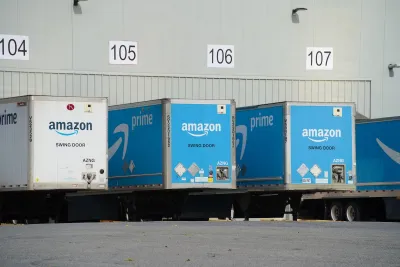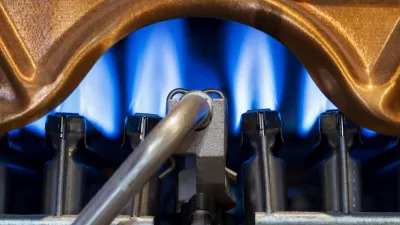The rise of ‘last-mile’ e-commerce warehouses — and their attendant truck traffic and air pollution — is disproportionately impacting the most historically disadvantaged parts of the city.

Air pollution from delivery trucks is impacting the health of New Yorkers, with an estimated 2,000 excess deaths per year attributed to long-term exposure to fine particulate matter, according to city data.
As Lauren Dalban reports in Inside Climate News, “The poorest neighborhoods often suffer the most in this equation—the PM2.5 levels from traffic are often higher in high-poverty neighborhoods, as well as the number of hospitalizations related to this pollutant.”
Dalban explains that the “last-mile warehouses” built for the distribution of e-commerce goods, which add to traffic and air pollution in surrounding areas, are often located in the poorest neighborhoods. Such warehouses can be built without a permit or environmental review in eight “commercial or manufacturing districts” around the city — many of which coincide with “environmental justice areas—places that have experienced a disproportionate amount of negative impacts from environmental issues due to historical disinvestment and social inequities.”
As part of an effort to redesign its trucking routes, New York City has launched a Commercial Cargo Bicycle Pilot Program and MicroHub program to encourage the use of smaller, low- or zero-emissions vehicles such as vans and cargo bikes for last-mile deliveries. According to Zach Miller of the Trucking Association of New York, “I think 80 percent of deliveries are happening to people’s homes right now in New York City, and that’s not what the truck route network was designed to do, so it is long past time to have this network be redesigned.”
FULL STORY: The Online Shopping Boom Comes at a Price—and Some New Yorkers Pay More Than Their Fair Share

Study: Maui’s Plan to Convert Vacation Rentals to Long-Term Housing Could Cause Nearly $1 Billion Economic Loss
The plan would reduce visitor accommodation by 25,% resulting in 1,900 jobs lost.

North Texas Transit Leaders Tout Benefits of TOD for Growing Region
At a summit focused on transit-oriented development, policymakers discussed how North Texas’ expanded light rail system can serve as a tool for economic growth.

Using Old Oil and Gas Wells for Green Energy Storage
Penn State researchers have found that repurposing abandoned oil and gas wells for geothermal-assisted compressed-air energy storage can boost efficiency, reduce environmental risks, and support clean energy and job transitions.

Santa Barbara Could Build Housing on County Land
County supervisors moved forward a proposal to build workforce housing on two county-owned parcels.

San Mateo Formally Opposes Freeway Project
The city council will send a letter to Caltrans urging the agency to reconsider a plan to expand the 101 through the city of San Mateo.

A Bronx Community Fights to Have its Voice Heard
After organizing and giving input for decades, the community around the Kingsbridge Armory might actually see it redeveloped — and they want to continue to have a say in how it goes.
Urban Design for Planners 1: Software Tools
This six-course series explores essential urban design concepts using open source software and equips planners with the tools they need to participate fully in the urban design process.
Planning for Universal Design
Learn the tools for implementing Universal Design in planning regulations.
Ascent Environmental
Borough of Carlisle
Caltrans
Institute for Housing and Urban Development Studies (IHS)
City of Grandview
Harvard GSD Executive Education
Toledo-Lucas County Plan Commissions
Salt Lake City
NYU Wagner Graduate School of Public Service




























